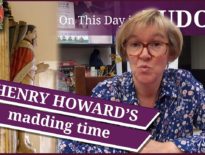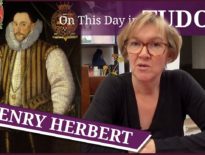On this day in Tudor history, 20th January 1569, not long after he'd given the best sermon of his life, Bible translator and Bishop of Exeter, Miles Coverdale, died in London.
Coverdale is known for completing the first English translation of the whole Bible and for his work on "The Great Bible", which was put in every parish church in England. Find out more about this accomplished Tudor man in today's talk.
Also on this day in Tudor history, 20th January 1557, Queen Mary I’s pensioners “did muster in bright harness” before her at Greenwich Park. Who were they and what happened? Find out in last year's talk:
Also on this day in history:
- 1525 – Death of Richard Bere, Abbot of Glastonbury. He was buried in the south aisle of the nave of the abbey church.
- 1558 – The state opening of the fifth Parliament of Mary I's reign. This is one of the only mentions of a public appearance by Mary after the second departure of her husband, Philip of Spain, in July 1557.
- 1607 – Death of Jacob Verzelini, glassmaker, in Crutched Friars, London. He was buried at Downe Chapel. His work, which includes a cylindrical crystal tankard with silver-gilt lid and base and goblets, can be found in the British Museum and in the Victoria and Albert Museum.
- 1618 – Death of Ferdinando Putlon, legal researcher and writer, at Bourton, near Buckingham. He was buried in the parish church at Desborough.
Transcript:
On this day in Tudor history, 20th January 1569, Bible translator and Bishop of Exeter, Miles Coverdale died. He was buried in the chancel of St Bartholomew by the Exchange, London, on 22nd January.
It is thought that Coverdale was born in the North Riding of Yorkshire in 1488, although nothing is known of his family or early life. He became an Augustinian friar and studied at Cambridge, where he was influenced by the reformist views of Robert Barnes. He had left the Augustinian order by 1528, when he fled to the Continent after preaching what would have been seen as heresy, challenging the miracle of the Eucharist, the worship of images and confession. He was in Antwerp by 1534 with John Rogers and William Tyndale. That year, an English translation of Campensis’s Latin work on the psalms was published in Antwerp, and it is believed that this was written by Coverdale, who had already started his translation of the Bible. His translation was completed in October 1535, and was the first English translation of the whole Bible.
Coverdale returned to England in late 1535 and published his translation of German hymns, “Goostly Psalmes and Spirituall Songs Drawen out of the Holy Scripture”, in London. This was followed by translations of other German religious texts. In 1537, Thomas Cromwell asked Coverdale to revise the “Matthew Bible”, a Bible which combined the work of Tyndale and Coverdale, and print it in Paris. However, there was trouble when one of those overseeing the printing was accused of heresy, and around 2500 finished copies were confiscated by the Inquisition and eventually burned.
Fortunately, the publishers, Richard Grafton and Edward Whitchurch, managed to flee Paris with some unbound copies. In April 1539, 3,000 copies of the “Great Bible” were printed, followed by another 3000 copies in spring 1540. This meant that a copy could be put into every church in England. On 6th May 1541, Henry VIII issued an injunction ordering “the Byble of the largest and greatest volume, to be had in every churche”, this was the Great Bible.
The “Act of the Six Articles” of June 1539 led to many reformers, Coverdale included, going into exile to escape persecution. Coverdale’s former mentor, Robert Barnes, was executed for heresy in July 1540, as was Thomas Cromwell. England was not safe for Coverdale. He and his Scottish wife, Elizabeth Macheson, fled to Strasbourg, where he stayed for three years, translating and writing tracts. While he was in exile, he worked as an assistant minister and headteacher. In London, in 1546, his books were condemned and burnt at St Paul’s Cross as works of heresy.
Coverdale returned to England in 1548, during the reign of Edward VI, and became Almoner to Catherine Parr, the Dowager Queen. He preached at her funeral in September 1548. After that, he became a Royal Chaplain and then Bishop of Exeter in 1551. The death of the Protestant Edward VI saw Coverdale put under house arrest when Mary I came to the throne, and losing his bishopric. The King of Denmark intervened to have Coverdale released, and in 1555 he went into exile, spending a few weeks in Denmark before heading to Germany, and then Switzerland, where he eventually settled in Geneva.
Coverdale set off for England in August 1559, in Elizabeth I's reign, and he spent some time at the London home of Catherine Willoughby, Duchess of Suffolk, a woman he’d known in exile, acting as a tutor to her children, Peregrine and Susan.
In 1564 he accepted the living of St Magnus the Martyr by London Bridge. His wife, Elizabeth, died in September 1565 and Coverdale married a woman called Catherine in April 1566. He resigned his living in the summer of 1566, but carried on preaching right up to the end of his life. In fact, he died immediately after standing in for a preacher at the church of St Magnus the Martyr in London. John Hooker describes how he was asked to preach when it was found that there was no preacher, and that he tried to excuse himself, pleading his age, infirmities, lack of memory and “his voice scarce to be heard”, but the parishioners wouldn’t take no for an answer and two men carried him into the pulpit, “where God did with his spirit so strengthen him, that he made his last and the best and the most godly sermon that ever he did in all his life”.
He was survived by his second wife, Catherine, but left no surviving children.
Although he was buried in St Bartholomew by the Exchange, his remains were moved to St Magnus the Martyr when St Bartholomew's was pulled down in 1840.



Leave a Reply